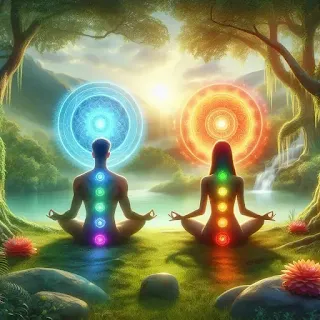Men and women are often considered equal in the realm of spirituality, a notion commonly encountered in discussions on the subject. However, it is essential to move beyond popular rhetoric and examine the facts with a critical and analytical mindset. Historically, the majority of those who have reached the pinnacle of spiritual realization have been men. This observation is not merely coincidental but points to underlying reasons that span across biological, psychological, social, and karmic dimensions.
By analyzing this subject through the lens of Vedic wisdom,
we can uncover deeper truths that go beyond modern-day narratives and delve
into the very nature of spiritual progress itself.
Karma Theory and Gender
According to the karma theory, gender is not a random
occurrence but a consequence of past actions (karma). Different karmic patterns
influence whether an individual is born as male or female, each serving as a
means to experience distinct life lessons and challenges.
- Some
interpretations suggest that an individual’s tendencies in past lives
shape their gender in the next.
- For
instance, excessive aggression or dominance might lead to rebirth as a
male, while excessive nurturing or self-sacrifice could lead to rebirth as
a female.
- Both
genders provide unique opportunities for spiritual evolution, and no birth
is superior to the other.
Life, from a karmic perspective, is a continuation of past
existences. Every birth is an opportunity for spiritual growth, with nature
determining the soul's contribution as either male or female. However, merely
being born male does not guarantee enlightenment, just as being born female
does not prevent it.
Most individuals—regardless of gender—become entangled in
mundane aspects of life, prioritizing survival, material pursuits, and societal
roles. Those who fail to elevate their souls may even regress spiritually. If a
person lives only for basic survival, they may not even be reborn as human
beings in their next life.
The Role of Chakras in Spiritual Evolution
In every human being, there are seven chakras, each
influencing personality, behavior, and spiritual growth. Understanding these
chakras helps in balancing energy flow, leading to holistic development.
1. Mūlādhāra Chakra (Root Chakra)
- Location:
Base of the spine
- Function:
Governs survival instincts, stability, security
- Balanced
State: Grounded, secure, confident
- Imbalanced
State: Fear, insecurity, instability
2. Svādhiṣṭhāna Chakra (Sacral Chakra)
- Location:
Below the navel
- Function:
Emotional identity, sensuality, creativity
- Balanced
State: Emotional stability, passion
- Imbalanced
State: Guilt, lack of motivation, overindulgence
3. Maṇipūra Chakra (Solar Plexus Chakra)
- Location:
Around the navel
- Function:
Personal power, ambition, self-confidence
- Balanced
State: Strong self-esteem, willpower
- Imbalanced
State: Fear of rejection, arrogance
4. Anāhata Chakra (Heart Chakra)
- Location:
Center of the chest
- Function:
Love, compassion, emotional balance
- Balanced
State: Unconditional love, empathy
- Imbalanced
State: Emotional detachment, resentment
5. Viśuddha Chakra (Throat Chakra)
- Location:
Throat
- Function:
Communication, self-expression
- Balanced
State: Clear communication, creativity
- Imbalanced
State: Fear of speaking, dishonesty
6. Ājñā Chakra (Third Eye Chakra)
- Location:
Between the eyebrows
- Function:
Intuition, perception, wisdom
- Balanced
State: Strong intuition, clarity
- Imbalanced
State: Confusion, excessive materialism
7. Sahasrāra Chakra (Crown Chakra)
- Location:
Top of the head
- Function:
Spiritual enlightenment, divine connection
- Balanced
State: Self-realization, cosmic awareness
- Imbalanced
State: Spiritual detachment, purposelessness
Chakras and Gender Differences
One key difference between men and women lies in the natural
dominance of certain chakras. Women tend to have their even-numbered chakras
stronger, while men have their odd-numbered chakras more active.
Women’s Stronger Chakras (Even-Numbered)
- Svādhiṣṭhāna
Chakra (Sacral Chakra): Governs emotional depth, nurturing, creation.
- Anāhata
Chakra (Heart Chakra): Enhances compassion, love, emotional
intelligence.
- Ājñā
Chakra (Third Eye Chakra): Strengthens intuition, perception beyond
the material realm.
Men’s Stronger Chakras (Odd-Numbered)
- Mūlādhāra
Chakra (Root Chakra): Governs survival instincts, material security.
- Maṇipūra
Chakra (Solar Plexus Chakra): Enhances confidence, ambition,
action-oriented nature.
- Viśuddha
Chakra (Throat Chakra): Governs communication, making men more vocal.
- Sahasrāra Chakra (Crown Chakra): Associated with enlightenment, cosmic awareness.
Chakras and the Path to Enlightenment
While inherent chakra strengths shape the fundamental
tendencies of men and women, spiritual enlightenment is not predetermined by
gender. Both possess all seven chakras, and the potential to awaken them fully
lies within the individual's efforts.
- Enlightenment
demands dedication, self-discipline, and relentless pursuit of truth.
- Although
men may have a natural advantage due to their dominant chakra arrangement,
women can reach the same state through perseverance.
- The
key is to balance all chakras and transcend material illusions (Māyā).
The journey toward enlightenment is about transcending gender-based tendencies and harmonizing all chakras. True spiritual progress does not depend on whether one is male or female but on their ability to overcome illusions and attain higher consciousness. The one who succeeds in balancing their energies and realizing their divine self—regardless of gender—achieves the ultimate goal of self-realization.
By Pradeep Mahaur – Pradeep Mahaur Magazine
Insights on Hindu Wisdom and Global Affairs from an Indic perspective.
spiritual
retreats, Spirituality,Hinduism, role of gender in spiritual journey, masculine-feminine balance spiritual growth, gender differences in spirituality explained, how gender shapes spiritual practice, spiritual journey , Spirituality,Hinduism, role of gender in spiritual journey, masculine feminine balance spiritual growth, gender differences in spirituality explained, how gender shapes spiritual practice, spiritual journey



Comments
Post a Comment
If you have any queries please let me know